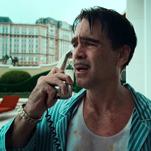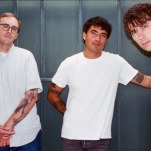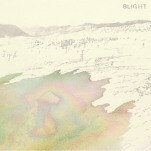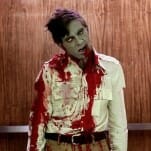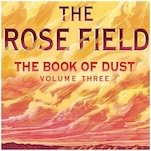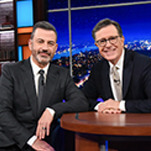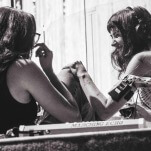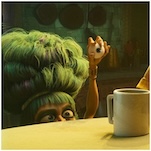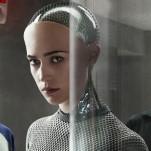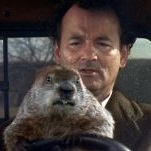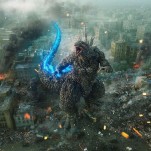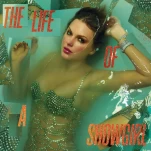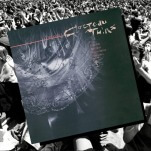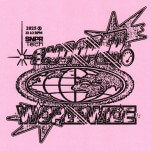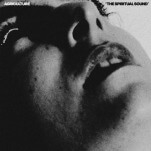The 50 Best Movie Jump Scares of All Time
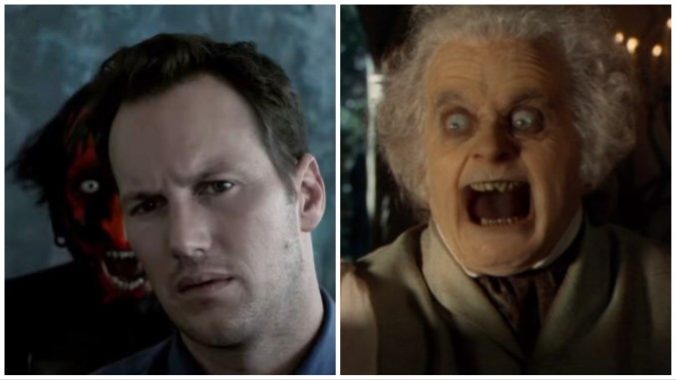
The convention of the cinematic jump scare is almost as old as the horror genre itself–since at least 1925’s The Phantom of the Opera, directors have used jump scares as both a weapon and a useful tool for controlling the tension level of a film. The jump scare works like a pressure release valve: A filmmaker allows suspense and tension to build and build to seemingly unbearable levels before deploying the scare, which releases that tension in a cathartic burst. The audience is left buzzing and full of adrenaline, ready to start the climb toward the next big scare.
Or at least that’s how classic jump scares have so often worked through the history of horror cinema, which is obviously where they’re most common. But here’s the thing: The jump scare doesn’t always conform to classic outlines, and it doesn’t always stay put in the horror genre, either. In truth, any kind of film can deploy a well-honed jump scare, from dramas and action movies, to even family adventures. Sometimes, the most memorable ones are the jump scares that pop up where you’d never expect them.
But what makes for an effective jump scare in the first place? Is it the build-up? The use of some element of novelty? Clever misdirection? Or a gruesome payoff? In most cases, it’s a synthesis of all those elements. The same goes for lame or ineffective jump scares, which tend to fall back too hard on elements such as shaky movement, hammering soundtrack scare chords, or well-worn genre tropes. But be careful–even trying to constantly subvert jump scare tropes can become tiresome quickly in its own way. The perfect jump scare requires a delicate balance.
Below, we’ve gathered 50 of the best movie jump scares of all time, from the horror genre and beyond. We’ve limited ourselves to only two basic rules:
— Only films are included, or else TV series/miniseries like The Haunting of Hill House would absolutely be present.
— Each movie can appear only once, to cut down on repetition.
So, let’s see which moments really made audiences leap out of their seats. Here are the best jump scares of all time:
50. The Phantom of the Opera, 1925
The Scare: The Phantom’s face
The reveal of The Phantom’s disfigured face in this, the most iconic production of Phantom, is considered by some to be the first truly recognizable “jump scare” in cinematic history. This is of course debatable, as there had been elements in other silent films before this point intended to get a shock out of the audience, but none quite so dramatic as this. There’s a true “boo!” element to our heroine lifting off the mask, only to be confronted with the skull-like visage of Lon Chaney, and audiences of the day had never seen such grotesquery on the big screen before. This was an unprecedented sight to behold.
Is it still likely to shock modern audiences? I think we can be honest: No, not really. Viewers are now familiar with an entirely different class of gruesome and violent imagery, having experienced an entire century of one-upmanship in what filmmakers can get away with on screen. But at the same time, we can always appreciate the artistry of this film that helped launch the era of the Universal Monsters–it’s especially fun if you can catch a modern screening of it with orchestral or chamber music accompaniment. That’s the best atmosphere for this original jump scare to be viewed in.
49. It Chapter One, 2017
The Scare: The slide projector
It’s been kind of fascinating to watch Andy Muschietti’s It go from being hailed as a horror revelation to an abject disappointment within only a few years time, mostly owing to the considerable letdown of It Chapter Two in 2019. The first film, though, still at least has some excellent jump scares to its credit–none better than the sequence in the garage where the Loser’s Club is examining a map on a slide projector before the device seemingly takes on a life of its own to begin showing old photos. The resulting jump scare–Pennywise manifests as a giant, projected clown and charges the group–has a certain strain of cartoonish silliness to it, but you can’t deny the effectiveness of the jump in the moment while you’re sitting in the theater. Sadly, this is a good example of the kind of jump scare that effectively walked the line of silly/scary in Chapter One, but unraveled in Chapter Two.
48. Citizen Kane, 1941
The Scare: The inexplicable cockatoo
It’s easy to forget that Citizen Kane, one of the greatest films of all time, contains a truly inexplicable, genuinely jarring jump scare that comes hurtling in out of nowhere, seemingly intent on giving audience members a heart attack for the sheer spite of it. The moment occurs at the beginning of a flashback, in the literal first frame a new scene, when a translucent cockatoo appears in the foreground of the shot with an unholy screech before flying away. There’s absolutely no way to see it coming, and the sound is so loud and jarring that I can only imagine it must have traumatized random theatergoers in 1941.
Why did the great Orson Welles insert such a random and bombastic jump scare into his satirical biopic? That has been a topic of much debate and discussion for decades, but Welles himself always contended that he literally included it just to “wake the audience up,” what he described slightly more seriously as an element of “theatrical shock effect.” Unsurprisingly, film scholars have longed to attach more meaning or symbolism to this odd moment, but Welles was adamant that the cockatoo had “a sort of purpose, but no meaning.” Make of that what you will, but it’s a hilariously jarring jump scare even all these years later.
47. House on Haunted Hill, 1959
The Scare: The gliding old lady
Director William Castle was a master of cinematic gimmickry, and there wasn’t any form of fright that he would have been ashamed to utilize. So naturally, the man loved his jump scares, and he packs quite a few of them into the likes of the original House on Haunted Hill. The cream of the crop is most definitely when an exploring Nora is searching for secret passageways in the basement, only to turn around and be confronted by the most hideously wizened, witch-looking old woman to ever set foot in front of a camera. Inexplicably, the woman then proceeds to glide away out of the scene, as if she’s being towed on rollerskates, while her upper body remains perfectly still. It’s a bizarre, unnatural image that will read as unintentionally funny to many viewers in 2023, but it’s still a top-tier vintage jump scare, likely one of the best-remembered of its era.
46. What Lies Beneath, 2000
The Scare: Paralyzed in the bathtub
It’s odd to think that Robert Zemeckis of all people directed Harrison Ford as a villain in 2000’s What Lies Beneath, in an out-of-character moment for both director and star. Most of the film is fairly rote, but it finds time for one skillfully employed jump scare toward its conclusion, when Ford’s nefarious Dr. Norman Spencer is preparing to stage his wife’s suicide by drowning in the bathtub after administering a paralyzing drug. As she lays in the bathtub helpless, Norman moves her head in order to remove a necklace, moving Michelle Pfeiffer’s face out of the shot. As her head then falls back into the camera’s line of sight, the face transforms into the bleached and waterlogged corpse face of Madison, the young woman Norman previously murdered. Suffice to say, Ford’s spastic reaction to this sight probably mirrored the motions of many in the theater seats. It’s a smart use of perspective in the context of a single, unbroken shot.
45. Halloween 4: The Return of Michael Myers, 1988
The Scare: Michael under the bed
Halloween is a series you might expect to be dominated by jump scares, but they’re really not present quite as much as you might expect, at least in the earlier installments. I must admit, though, that perhaps my favorite in the series is from the often maligned Halloween 4, a film I’ve defended here on any number of occasions as one of the best Halloween sequels whose reputation has been dragged down by its unfortunate continuation in Halloween 5. The scare happens early on, when we’ve barely introduced our protagonist Jamie (the wonderful Danielle Harris), in the form of a dream sequence, though its nature as a nightmare isn’t immediately obvious to the viewer.
In the sequence, Jamie is alone in her dark, incredibly creepy bedroom as a thunderstorm rages outside. She’s on edge as her closet door repeatedly creaks open and she shuts it, tentatively taking a few steps toward the door … when the hand of Michael Myers shoots out from under her bed, attempting to drag her down into oblivion. It’s a classic case of misdirecting the audience’s attention, before then springing the jump scare from an unexpected source. You can be certain that my childhood self feared “hands from under the bed” for years afterward, thanks to this scene.
44. Grave Encounters, 2011
The Scare: A bathtub full of blood
Found footage horror and jump scares go hand in hand, two peas in the same pod. The genre is replete with jump scares, the downside being that the audience tends to get cynical about them quite quickly, and they suffer from diminishing returns. Still, some of the best jump scares of the last few decades have been within the context of found footage horror flicks, and that includes this one from 2011’s still underseen Grave Encounters.
The film sees a team of charlatan ghost hunters–not-so-subtly satirizing Ghost Adventures and Zak Bagans, to hilarious effect–locked inside a “haunted” asylum where they unsurprisingly begin experiencing genuine paranormal phenomena. The film takes some delightfully metaphysical turns along the way, slowly building in tension until it reaches the inevitable screams and shaky-cam running phase, which is punctuated by this great jump scare involving a bathtub the crew has passed several times in the film before. Only now, the bathtub is somehow filled with blood? And when one crew member ventures a bit too close, he finds himself pulled to his doom in chaotic fashion. I love that the crew doesn’t immediately just run, either–they tip over the bathtub trying to save their friend, only to find that both the victim and the attacker have vanished. Only the blood remains. It’s a great touch that elevates this jump scare.
43. REC, 2007
The Scare: The boy in the attic
Spanish possession/zombie horror fusion REC remains one of the great found footage horror films of the 2000s, punctuated by many great jump scares–probably the best known is the final images of the film, in which the protagonist is pulled away by an invisible force into the darkness. That moment, though, comes in the middle of an entire suspense/scare sequence, which makes it harder to include in a list of dedicated “jump scare” moments. Fitting the bill in a much more classic way is the moment when the TV news crew we’re following attempts to find safety in the building’s attic, only to find a zombified/possessed little boy snarling face-first into the lens. The 360 degree rotation performed by the camera here is what makes the jump scare work–you know it’s coming, but for a moment you think maybe the camera has completed its rotation and there won’t be a scare. And of course, that’s when the scare arrives. This is extremely conventional, but perfectly executed.
42. Pee Wee’s Big Adventure, 1985
The Scare: Large Marge
Tim Burton’s love of the macabre is quite well documented, so it makes perfect sense that he would find time to insert exactly one scary scene into what is otherwise a classic family adventure comedy starring the one and only Pee Wee Herman (Paul Reubens). It honestly seems like traumatizing kids must have been Burton’s primary goal, or why else would he have unleashed Large Marge on us? The truck driver’s story about “the worst accident I ever seen” is peppered with wonderfully evocative preamble, like “there was a sound like a garbage truck dropped off the Empire State Building!”, but the main event is her split-second transformation into a claymation monster, which probably sent a few unexpecting little kids running for the aisles. Fun fact: The stop-motion animation of Large Marge was provided by none other than the Chiodo Brothers, who would go on to direct Killer Klowns From Outer Space three years later in 1988.
41. Smile, 2022
The Scare: A lady loses her head
Smile contains some of the visual language of the modern crop of so-called “elevated” or arthouse horror cinema, but it’s also not above throwing totally shameless jump scares at the viewer, ultimately putting the film into a conceptual middle ground. There are quite a lot of well-executed jump scares in the film, but none hit harder than this one where protagonist Rose is followed to her car by her sister, who knocks on the window to talk to her, only for her head to then swing down like her neck has become a well-cooked strand of spaghetti. It’s a very nifty effect, delivered in an extremely unexpected way, especially given the broad daylight setting and the unassuming way the scene begins. It’s an absolute crime that this particular scare was spoiled for some viewers by the fact that it was included in one of the film’s first trailers–it’s too good to give away for free.
Note: This jump scare definitely looks to be directly inspired by a similarly framed car window jump scare in Argentinean director Demian Rugna’s cult 2017 horror film Terrified.
40. Prince of Darkness, 1987
The Scare: A double dream bed scare
For just about as long as there have been dream sequences in film, dreams have been used to deliver jump scares. They’re perfect for the purpose, allowing anything at all to threaten or happen to the protagonist, with no lasting consequences. Subsequently, jump scares ending dream sequences became seen as a hardy cliché, which led to the birth of the double dream jump scare fake out–when a character awakes from a dream and everything seems safe, only to deliver a second jump scare and second jolt awake. One could argue that even the double dream jump scare became cliché as well in short order, but not before John Carpenter’s underrated Prince of Darkness delivered one of the better examples of it.
This scare works particularly well in context because it comes at the end of the film, and follows a format of dream we’ve seen repeatedly throughout–a shadowy figure emerging from a church, finally revealed here. None of the previous instances end with a jump scare as a stinger, however, which leaves the viewer to assume the same will be true here. The particular way the scare is revealed, with a character in bed rolling over to find something hideous next to them, has also become a trope of its own in the decades since Prince of Darkness was released.
39. Ju-On: The Grudge, 2002
The Scare: A ghost under the covers
Hiding under the covers in a horror movie is a symbolic act, evocative of the childhood fears we pretty much universally have experienced: Every kid has at some point been convinced that ghosts or monsters are in their room, and that only by covering every inch of exposed flesh under the bed sheets and blankets can they be safe. A ghost appearing under the covers thus shatters the expected safe haven in a way that is rather violating and transgressive–it’s such an oddly intimate place to find a spirit from beyond the grave. You can tell that this particular jump scare in Japan’s Ju-On: The Grudge was influential because it’s been copied so many times since in other films breaking that safe space barrier that the sheets represent, but here it’s the little things that add to the mood, like the protagonist attempting to allay her nervousness with TV white noise, only for that to betray her as well. After this film, it was hard to look at hiding under the covers the same way again.
38. Halloween, 1978
The Scare: Everyone’s entitled to one good scare
Here’s the thing with the Halloween franchise: It’s actually not nearly as packed with jump scares as you might expect it to be. The later entries are, sure, but the original film gets by more with the dread of not knowing where Michael is, or the slow, creeping horror of finally seeing him calmly walking toward you like an unkillable monster. John Carpenter’s all-time slasher classic has only a few of what we’d call classical jump scares, but I’m partial to this fake-out one for how profoundly influential and imitated this kind of scare would end up being to this day. When this scare happens, Laurie has just seen Michael moments earlier, standing behind the hedges in broad daylight, and is understandably nervous. She continues to glance backward at the hedges as she continues on her way … and stumbles right into Sheriff Brackett, who seems to enjoy the little scream he provokes from her, before delivering the iconic line: “You know, it’s Halloween. I guess everyone’s entitled to one good scare, huh?” How right he is.
This is of course a sterling example of the fake-out jump scare, found so often in the first act of numerous horror films of the 1980s, 1990s and beyond. This is the “friend’s hand on the shoulder” jump scare. The “it was only a cat” jump scare. Just a little something to goose the audience early in the film, so they don’t relax too much before the real danger arrives. This might not be the jump scare someone would imagine first when you invoke the Halloween series, but I’d wager this is the scare that has actually been mimicked and replicated the most in the almost 50 years since.
37. Phantasm, 1979
The Scare: “BOY!”
There’s a long and proud tradition of ending your horror film with a final jump scare in the closing moments, and an even longer tradition of jump scares involving mirrors, several others of which we will see on this list. The “mirror scare” list is far too long to count, but Phantasm has one of the most enduring examples. It comes right at the end of the film, when protagonist Mike seems to have overcome the threat of the supernatural Tall Man (Angus Scrimm). Retiring to his room, Mike tilts the full-length mirror, revealing the Tall Man standing in a corner. The villain actually goes unnoticed for a moment or two before issuing a single, threatening “BOY!” at the protagonist, who is subsequently grabbed by monstrous arms that break through the mirror itself, pulling him into what appears to be a black void beyond it.
This ending is quite similar to the jump scare finale of the original A Nightmare on Elm Street, but the abruptness and jarring conclusion of Coscarelli’s Phantasm really nails home its air of hopelessness, making this one age more gracefully from the slightly silly effects used in Wes Craven’s landmark slasher.
36. The Invisible Man, 2020
The Scare: The paint bucket
The Invisible Man is a pretty spectacular thriller, a rather incredible rebuke to the likes of 2017’s overwrought The Mummy when it comes to creating an example of just how the classic Universal Monsters could be revived in the current filmmaking age: With modernization and creativity. It all seems so obvious in retrospect, because of course a modern remake of 1933’s The Invisible Man should be about a woman being stalked by her millionaire tech bro ex-boyfriend, who wastes a groundbreaking invisibility suit on petty personal vengeance. Surely if Elon Musk possessed such a suit, he’d be hiding in an ex-lover’s attic right now.
Of course, the premise that an invisible stalker or assailant is hiding within the corners of your own house is one rife with opportunities for jump scares. This pays off in a big way when protagonist Cecilia (a scintillating Elisabeth Moss) is searching an attic when she begins to suspect someone may be ascending the ladder leading to her. Throwing a bucket of paint down into the seemingly empty air, it instead reveals our first outline of the invisible man–and learning that an invisible attacker is actually mere feet in front of your face is understandably pretty shocking.
35. Hereditary, 2018
The Scare: The “click” in the car
In submitting Ari Aster’s Hereditary for this kind of list, I have to imagine that most viewers would probably point to one of the film’s jump scares in the ending sequence, such as seeing Annie climbing on the wall behind Peter, or seeing her come hurtling out of the dark corner of a room. And those are certainly fine examples of the style, in a movie that is otherwise pretty short on traditional jump scares, but I think the earlier sequence with Annie in the car when she suddenly hears Charlie’s telltale “click/pop” sound, is even more of a true “jump” in the moment. It serves to illustrate the crumbling mental faculties of Annie, portrayed so devastatingly in Hereditary by Toni Collette, following the shocking death of her daughter, and fits with the film’s internal logic about the transitory nature of the soul. It’s also a great illustration of just how big a gasp you can get out of an aural-only scare with a single syllable. Talk about doing a lot with a little. Everybody was emulating this noise in the wake of Hereditary.
34. Psycho, 1960
The Scare: Arbogast meets Mother
The infamous shower scene of Psycho is no doubt the first thing that almost anyone would think of, when asked to consider Alfred Hitchcock’s landmark psychological horror film, but it’s not really the scene of Psycho with the most legitimate “jump” to it. That would instead be the death of private investigator Arbogast, who sneaks his way into the Bates house in an attempt to speak with Norman Bates’ ailing mother … only to be met at the top of the stairs by Mother and her butcher knife. The effectiveness of this scare is really down to a synthesis of all its elements–the long, slow build-up of Arbogast approaching the house and ascending the staircase builds the tension, before the film’s iconic screeching strings and the disturbingly lithe movement of the Mother (framed in a spectacular overhead shot) key us in to the fact that there may be more to this little old lady than meets the eye. Even though you can feel this death coming, it still manages to feel shocking, which is a testament to Hitchcock’s prowess.
33. Repulsion, 1965
The Scare: The man in the mirror
We’ve already touched on the “mirror scare” in this list, which was inevitable–it’s probably the single most overused horror cliché of the last four decades. The protagonist adjusts their bedroom or bathroom mirror, and then BAM, someone appears behind them! But Roman Polanski’s Repulsion still deserves all the credit as an innovator, because this might very well be the first concrete cinematic instance of what we would recognize as the modern mirror scare. Polanski’s claustrophobic film follows a shut-in, socially anxious and traumatized woman as she descends into madness while occupying her sister’s apartment, being especially terrified by the male form and all its implied sexual aggression. She sees the specter of threatening males everywhere … including in her bedroom mirror, although Polanski pulls off the scare in a bit more subtle and subjective way, allowing the reflective surface to very quickly move past the image of a man, so fast that we can’t really be certain what we’ve seen. Nor do we even see protagonist Carol’s face at the moment: We instead read her posture, which stiffens and freezes as she goes through a quick set of mental calculations. She doesn’t whirl around–we can interpret her response as denying to herself what she just saw, as she fears the erosion of her sanity. It’s an extremely effective micro-moment of Repulsion’s disturbing journey.
32. Poltergeist, 1982
The Scare: A clown under the bed
“Children with toys far creepier than any real child would suffer to be in their presence” is of course well-worn horror trope material, with perhaps no film making a greater contribution to that canon than Tobe Hooper’s Poltergeist. Because honestly: Can anyone among us believe that any kid would want this clown marionette in their room? Perched on a chair, watching them sleep? I don’t think so. This jump scare is empowered by a few things. For one, it comes deep into the movie’s runtime, when young Robbie’s fear of the clown doll has already been well established for a long time–but we’ve never actually seen the doll do anything deserving of his fear yet. Moreover, this scare comes along when the house has supposedly been “cleaned” by a sort of spiritual exorcism from Tangina (Zelda Rubinstein in her iconic role), and we’re meant to think the danger has passed. In fact, we seem to see Robbie coming to accept that he no longer really needs to cover the clown doll up at night in order to feel safe … and naturally, that’s right when the clown doll disappears from its chair. What ensues is a guessing game of where the clown has ended up, with a classic pay off. Decades later, this is probably one of the most fondly remembered horror film moments of the 1980s.
31. The Dark Knight, 2008
The Scare: The body at the window
You’ve got to love that even a cinephile and technician on the level of Christopher Nolan couldn’t quite resist the impulse to stick a totally unexpected jump scare in the middle of what is still widely regarded as the best superhero film of all time, 2008’s The Dark Knight. This one is genuinely unfair to the audience to be honest, because there is no way in hell you could possibly sense it coming in any way, shape or form. Harvey Dent is having a conversation with Gotham’s mayor, being warned about the political pitfalls that stand in his way as the single honest man in a system full of corruption and back-alley dealings, when the mayor walks to his window to look out on the festering city that is Gotham. No sooner does he finish his sentence than a dead body dressed as Batman swings down and slams into the window, a noose around its neck. If you’ve never seen this film before, it’s a moment that can’t help but make you jump. Just how did The Joker even manage to rig this corpse to spook the mayor so perfectly, at the exact moment he walked to his window, anyway? Oh well, Nolan knows that you never let logistics stand in the way of a good jump scare.
30. The Exorcist, 1973
The Scare: The devil’s face
It’s a little tough to decide whether or not the infamous, split-second appearances of the demon Pazuzu’s face throughout William Friedkin’s The Exorcist really qualify as traditional jump scares, but we would argue that they do serve a similar function. You could think of them as almost subliminal forms of the jump scare, imagery that appears and vanishes so quickly that it doesn’t give the viewer–especially the first time they see the film–enough time to really process the contents of the image, only to register that something is deeply wrong. These flashes of perception are one of the factors that helps The Exorcist to feel like a somehow stained or unholy vessel, all these years later–it feels as if the evil of the story is somehow seeping into the celluloid itself and infecting it, which naturally leads the viewer to worry on a subconscious level that they’ll be the next ones infected by it. They’re likely the fastest and most subtle of all the jump scares on this list.
29. Jurassic Park, 1993
The Scare: “I think we’re back in business!”
The thing that is so great about Jurassic Park’s best jump scare is that it’s the payoff to so much groundwork the film goes out of its way to lay about the nature of the raptors for its entire runtime leading up to this point. We hear so much about them, their capabilities and their frightening intelligence, but we never get a full-on look at one–Spielberg holds the payoff of the raptors at arm’s length for a long time, before finally springing it on the viewer here during what otherwise looks like a moment of triumph for Ellie Sattler. Oh, you think you’ve solved the power problem? Well, here’s a new problem, and it’s already ripped the arm off Mr. Arnold! Likewise, the electrocution of Tim only moments earlier makes the audience feel as if the source of danger is located elsewhere, before the Velociraptor’s head comes smashing into the frame. It’s a landmark moment for both practical effects and the jump scare itself.
28. Sinister, 2012
The Scare: The lawnmower tape
Sinister’s collection of found footage murder tapes have gone on to live in horror infamy, but the film’s greatest contribution to the world of jump scares is a scare that ultimately relies much more on atmosphere, sound and a performer’s reaction than anything we actually get to see on screen. Ethan Hawke’s protagonist is watching a series of disturbing tapes created by an apparent serial killer, each depicting families being killed in gruesome ways. It culminates in a tape from the killer’s POV as a lawnmower is pushed across a yard in the middle of the night, before the mower rolls over a bound victim. That no doubt sounds like an invitation for extreme gore, in the vein of something like Dead Alive’s infamous lawnmower scene, but the reality is that in Sinister we see very little–the events are depicted so quickly that we can only barely register the human figure. Rather, it’s the jarring sound effects, near silent build-up and especially Hawke’s absolutely horrified, instinctual reaction to scramble away from the projector that really sell the jump scare. Thanks to director Scott Derrickson’s savvy choices here, I wouldn’t be surprised if this was one of those scenes that viewers mistakenly remember as being far more gory than it actually is, years later.
27. Cat People, 1942
The Scare: The Lewton bus
Another one of cinema’s earliest and best known examples of the jump scare can be found in Jacques Tourneur’s classic Cat People–and yes, the film is directed by Tourneur, who always somehow ends up getting left out of Cat People mentions in favor of producer Val Lewton. Indeed, even the jump scare technique itself is credited with Lewton’s name, even though it was editor Mark Robson who reportedly innovated it. Regardless, this is a far more sophisticated version of the art of the jump scare than the likes of Citizen Kane’s randomly interjecting cockatoo a year earlier.
The famed jump scare of Cat People is one of those that absolutely requires the context of the entire scene building up to it in order to be effective. A woman is walking home alone at night, but begins to feel she’s being followed by another person … or is it something more supernatural? She hurries along the street, the only sound being her shoes clacking along the concrete. She sees nothing, but her nervousness mounts to almost full-on panic anyway–she instinctively knows she’s being stalked by something in the shadows. And then, just as her fright reaches its height, a city bus suddenly slams to a stop alongside her, with a large hiss–not coincidentally, sounding very much like the hiss of a big, predatory cat. It’s the perfect thematic jump scare for the film it’s in.
26. Shock, 1977
The Scare: A boy’s unexpected transformation
Shock was the last film in the decorated career of Italian giallo and supernatural horror auteur Mario Bava, and he ended up saving one of his best jump scares for the end. The film is the story of a woman and her young son being menaced by the presumed spirit of her deceased ex-husband, who seems to wish to be reborn in the young man’s body. Throughout the film, this manifests as Carlo (the ex-husband) seemingly influencing the young boy’s actions, a la The Turn of the Screw.
The shocking jump scare, meanwhile, comes at the end and represents an expert use of what filmmakers call the “Texas switch,” which simply means when an actor briefly leaves the frame and is replaced with a different actor. The young son runs down a hallway at his mother, and as he dips out of sight and the camera swings up, the spirit of the full-grown man pops up in his place. It’s quite simple to understand how the effect is done, but it’s disturbingly effective all the same. This one is just all about the timing of the action, which had to be just right. The same effect has subsequently been remade on a number of occasions, such as in 2019’s The Prodigy. You can see the two scenes compared below.
25. Candyman, 1992
The Scare: Helen is attacked
Windows, cabinets and mirrors are a big running visual theme of 1992’s deeply influential gothic semi-slasher Candyman, so it makes sense that the film would mess around with the conception of the mirror jump scare itself, finding a fresh way to deliver it in the process. Virginia Madsen’s protagonist Helen is key to this, displaying an instinctual form of what almost seems to be genre savvy. Alone in her home, she feels uneasy in the bathroom when she swings open the medicine cabinet mirror. As if suspecting that she’ll be the victim of a mirror scare when closing it–as we’ve seen in so many other films, especially with this style of mirror–she instead turns around to apprehensively look and listen to the empty hallway behind her. And that’s when the scare comes, not through the mirror but through the medicine cabinet behind her, as the Candyman’s hooked claw comes bursting through the wall, sending her running. It’s one of the best inversions of the mirror jump scare you’re likely to find.
24. Hell House LLC, 2015
The Scare: The clown head tilt
The Hell House LLC series of found footage horror films has at this point crawled down a deep rabbit hole of lore and self-reference through its various sequels, but the original is still a very impressive shoestring production that gets the maximum amount of creepiness out of the smallest imaginable amount of resources. Even inanimate–or largely inanimate, anyway–objects manage to get major jump scares in this film. Case in point: The bloody clown mannequin, which seems to have something of a life of its own, but only when no one is watching. The series’ most beloved jump scare takes advantage of this by simply adjusting the clown slightly in the course of an unbroken shot, which certainly startles the poor camera operator, even though he fails to grasp the actual magnitude of the moment at the time. This makes it a rare example of a jump scare with what one might call a “delayed scare,” as the character who is startled by the clown changing positions is freshly terrified later on when he learns that the dummy heads aren’t supposed to be poseable or movable. This is a great example of how subtle an action can still generate a jump scare.
23. Lake Mungo, 2008
The Scare: Alice’s phone footage
If something like the Cat People jump scare requires the viewer to immerse themselves in the scene leading up to it, Lake Mungo’s best jump scare more or less demands you take in the entire film to really feel the profound weight of it. This is a low-budget Australian film that one might accurately refer to as true crime mystery horror, or even “horror drama,” cobbled together from police investigation footage and home movies as a family tries to come to terms with the recent drowning death of teenage daughter Alice. Key to solving the mystery is Alice’s cell phone and the mysterious footage she captured herself in the days leading up to her death. We see snippets of this macabre footage throughout, but the images always freeze frame in the same point, which effectively creates an expectation in the audience that this point is the “end” of the footage. The jump scare then takes advantage of that incorrect expectation by giving us just a little bit more at the perfect moment. Only the context of the entire film can really give this moment the gravity it will have in a proper viewing.
22. Carrie, 1976
The Scare: Rest in peace, Carrie
The inclusion of a final jump scare in a film, a “stinger” to give the audience one last jolt and keep them chattering through the credits, is an omnipresent convention these days, so well established that by the time of Scream it was already being satirized. Carrie, however, is the single biggest reason why that trope eventually became cliché, given its iconic ending jump scare. This one also qualifies under the dream-based jump scare category, with the film making the odd decision to show Sue sleeping in bed before we get into the scene, keying the audience into the fact that they’re seeing a dream. Regardless, that doesn’t take away from the initial shock of Carrie’s bloody hand emerging from the rubble of her burned down home to grab hold of poor Sue, more or less the only halfway decent person in Carrie. Today, this is the kind of jump scare an audience would no doubt be expecting, but in 1976 it’s safe to say that circumstances were quite different.
21. The Haunting, 1963
The Scare: Eleanor sees Grace
Robert Wise’s The Haunting is easily one of the best ghost movies of all time, and likely one of the most effectively creepy and frightening films of the 1960s. Still likely the most faithful version of Shirley Jackson’s The Haunting of Hill House, it’s a needling psychological excavation of the evil house and its apparent will to possess more souls for its collection. Seemingly most vulnerable to that kind of influence is poor Eleanor, an empathic woman with deep-seated emotional scars that leave her teetering on the edge of collapse. Everyone around Eleanor, of course, is all too happy to seemingly take advantage of her fragile mental state for the sake of the ongoing paranormal investigation of Hill House, which begs the question of where the true source of the home’s malevolence really lies.
This jump scare occurs as Eleanor wanders the home, seemingly slipping deeper into irrationality and paranoia, finding herself at the sight of one of the house’s most gruesome deaths. Talked down from her ledge by Dr. Markway, the tension of the scene slowly abates as it seems everything will be okay … only for Markway’s frenzied wife Grace (also seemingly being affected by the house) to make an unexpected appearance, sending Eleanor into a full-on panic. The unhinged look in the eyes of actress Lois Maxwell as Grace really helps to seal the deal.
20. Paranormal Activity 2, 2010
The Scare: An entire kitchen revolts
None of the many Paranormal Activity sequels are able to replicate even a fraction of the overall white-knuckle tension that audiences experienced during the release of the original film, which was a special moment in found footage horror that can only be compared to the pop-cultural effect of The Blair Witch Project. What the sequels can rest their laurels on is at least one or two great jump scares per entry, though. Of those, perhaps the finest in its simplicity is this one from Paranormal Activity 2, which sees a woman alone in the middle of the day in her kitchen when all hell suddenly breaks loose. It’s such an innocuous setting: Who among us hasn’t sat at the kitchen table taking in the mid-morning sun with a cup of coffee? What would you do, if in that moment, every single cabinet and drawer suddenly exploded open at once? Burn the house down and never return, perhaps? Who could blame you if you did?
The effectiveness of this scare is really a testament to the practical effects workers on this movie, and how beautifully they synch up all the action happening at once.
19. It Follows, 2014
The Scare: The tall man
Writer-director David Robert Mitchell was wise to never key us in with too much information or mythology on the titular creature of It Follows, a being that seems to fall somewhere between terrestrial creature and supernatural force. Our understanding of it is rooted only in what the last few teenagers to encounter “It” have seen–which is to say, not much. We do know that it marches ceaselessly in the direction of its current target, but also that it can take on many different forms and appearances. Why it does this is a mystery, though “It” does seem to possess a certain infernal intelligence.
The jump scare involving the “tall man” takes place in the home of protagonist Jay (Maika Monroe), who first encounters It in one form downstairs before rushing upstairs and locking herself in her room. Twice, her friends knock on the door and ask her to let them in, which she fearfully does. The second time she opens the door, finding only her friend Yara, the tension seems to deflate–we can see that there’s no one else there. But the skillful use of a darkened hallway manages to somehow hide the approach of an unnaturally tall man, who looms up behind Yara out of the darkness like he’s just stepped out of a portal from hell. Jay rightfully flees screaming from the balcony.
18. Day of the Dead, 1985
The Scare: The opening dream fake out
There are plenty of dream sequence jump scares on this list, but it’s something else entirely to begin your film by dropping the viewer straight into one before the characters have even been introduced. George Romero employs that clever little trick in 1985’s zombie masterpiece Day of the Dead, opening with protagonist Dr. Sarah Bowman (Lori Cardille) in a windowless concrete cell, a metaphor perhaps for how humanity’s slim percentage of survivors have been driven to the absolute breaking point by the victorious undead uprising. Bowman approaches a calendar at the far end of the room–the only focal point in the drab, featureless cell–and reaches to touch it, only to be horrified as dozens of zombie arms come bursting through the walls right in front of her face. It’s a gorgeously pulled off piece of FX, as the concrete walls in front of her look absolutely real and unassuming before suddenly crumbling under the weight of nightmare logic.
17. The Fellowship of the Ring, 2001
The Scare: Bilbo, or Gollum?
Sometimes, it’s not so much the scare itself, but the context in which the jump scare arrives. Fantasy geeks, children and families were already an hour or two into Peter Jackson’s seminal adaptation of The Fellowship of the Ring before the director chooses to employ one of the more out-of-left-field jump scares in cinematic history, although in his defense it makes perfect sense within the context of the story. Bilbo is, after all, a former bearer of the One Ring, and we know that the evil of the Ring has a corrupting effect that bends all creatures to its will, given time. In the jump scare seen here, we are given the briefest of glimpses at how Bilbo might have ended up if he had allowed the Ring to corrupt his spirit in the same way as Gollum, but it’s blessedly short. It’s simply a flare; a peek at one possible future that is thankfully averted by the innately good, humble nature of hobbits. But man, this must have traumatized some of the little kids in attendance who had no way at all to know it was coming. It’s as if Jackson turns back into his New Zealand, Dead Alive-era self for about three seconds.
16. The Thing, 1982
The Scare: Norris and the defibrillator
For horror geeks, it’s sometimes difficult to judge the effectiveness of a jump scare when it’s in a piece of footage you’ve seen dozens of times, because it requires putting yourself back in the mental headspace of someone seeing a movie for the first time. The FX-laden sequences of John Carpenter’s iconic The Thing all sort of fall into this camp, beloved as the film is by horror fans around the world. You might not even think of The Thing as possessing many classical jump scares, but it does: Notably, the payoff to the “blood test” sequence, and the beginning of the Norris transformation sequence.
As an exercise, then, let’s put ourselves back in the shoes of someone watching this for the first time. Protagonist MacReady (Kurt Russell) has just infiltrated the camp after being suspected of being a host to The Thing. In a standoff with the entire rest of the group, he threatens them all with dynamite, and that’s when geologist Norris appears to suffer a fatal heart attack. Quickly setting aside hostilities in an attempt to save Norris’ life, the crew members gather around as physicians Dr. Copper charges defibrillator paddles. He then proceeds to use those paddles … only for Norris’ chest to burst open and instantaneously transform into hideous alien jaws, which clamp shut on Copper’s hands, biting them off at the wrist and killing him. Who in their right minds would see that one coming? I would love to have seen the reactions to this in movie theaters in 1982.
15. An American Werewolf in London, 1981
The Scare: The double dream sequence
We’ve already seen a “double dream” jump scare on this list courtesy of John Carpenter’s Prince of Darkness, but An American Werewolf in London probably represents the apex of the form. It’s one of those cases where the initial horrifying dream sequence–in which protagonist David (David Naughton) and his family are slaughtered by mutant Nazi werewolves–was bad enough, particularly David’s helpless eyes as his throat is messily slit, but the second dream attack on the lovely Nurse Alex (Jenny Agutter) is just adding insult to injury. David has already been sufficiently scarred by the unthinkable images of watching his parents and child siblings murdered by monsters in front of him–after what we just saw, the audience is primed to allow the nurse to allay the injury. She assures us that she has “just the thing” for the situation. She reaches for the blinds to flood the room with the cleansing light of day … and is attacked by another inexplicably present Nazi werewolf, who guts her brutally in front of David. His reaction on waking for a second time is one of the most well-earned “holy shit!” exclamations in cinema history–how could you ever be comfortable going to sleep again?
14. Wait Until Dark, 1967
The Scare: Alan Arkin’s leap
Wait Until Dark is a tense psychological thriller about unfortunate blind woman Susy (Audrey Hepburn), who accidentally comes into possession of a doll filled with smuggled narcotics. Wanting to collect the valuable contents, she is menaced by a group of con men and criminals who try to extract the doll from her, first via trickery and then by force. We’re left with the perfect setting for a home invasion story, with the ultimate sympathetic protagonist who must battle back against the invaders by utilizing her intelligence, repeatedly plunging the apartment into pitch blackness to level the playing field against the aggressors.
At the culmination of the film, it seems that Susy has incapacitated the murderous Roat (Alan Arkin) after stabbing him in the midsection, but she’s unable to escape the apartment through the chained front door. Traversing the room in the dark, she walks across the length of the frame before being ambushed by a leaping Roat, who hurtles across the screen to grab her ankle. The power of this jump scare is all in its framing: We automatically tense up as Susy enters the area of danger, but instinctively start to let our guards down as she moves away from it. Arkin’s physicality and tremendous jump takes both Susy and the audience completely by surprise, resulting in a well-earned scream.
13. Signs, 2002
The Scare: The birthday party footage
It’s funny how a jump scare can deliver precisely what you’re expecting to see in the moment and still be shocking, and the infamous birthday party footage from Signs is a prime example of that. I mean really, it’s an alien invasion horror movie, and we’re seeing a piece of news footage that the anchor has already warned us is disturbing. What else is it going to be, if not a snippet of an alien being?
And yet, it’s the directorial expertise of M. Night Shyamalan that makes it all come together. Setting the clip through the context of a child’s birthday party is a beautifully wicked touch, surrounding the camera with bobbing little heads that give us the feeling that we’re in danger of missing the payoff, should one of them get in the way at the wrong moment. This creates a certain sense of anxiety, paid off by both the shrill screaming of the party guests and the at-home reaction of Joaquin Phoenix’s Merrill. Showing the footage twice is also a nice touch–it’s not often that you get to instantly replay a jump scare and then dig deeper into the unease of the image.
12. Alien, 1979
The Scare: The death of Dallas
Ridley Scott’s Alien plays a clever trick from its earliest moments by never really signaling that Sigourney Weaver’s Ripley is anything amounting to the “main character” of the film–if anything, the audience is likely conditioned to believe that Tom Skerritt’s Captain Dallas will be the closest thing to a traditional protagonist … and that’s why his death works so well. We know that hunting an alien life form on your decaying septic tank of a space barge is surely going to be dangerous work, but audiences likely wouldn’t have been expecting Dallas to actually die, not when most of the other supporting characters are still alive. And yet, when it comes right down to it there’s not a thing that Dallas can do other than more or less sit and wait for the superior life form to show itself, moving silently and invisibly through the air shafts of the Nostromo. The maddening beeps of the movement tracking system are no help at all when up against a creature that can seemingly be anywhere it wants to be at any moment. One gets the sense that the xenomorph will only show itself when its incalculable alien intelligence decides it’s time for you to die.
11. The Sixth Sense, 1999
The Scare: Toni Collette and the breakfast table
There are much flashier and more direct examples of the jump scare that one can point to in M. Night Shyamalan’s still-chilling ghost story The Sixth Sense, but I believe the one I’m highlighting here is actually the most effective of them all. In fact, this might be the most underrated jump scare on the entire list, if only because it’s not the one I think most people would think to nominate when compiling a list of jump scares. But it’s startlingly effective.
The scare happens during a normal breakfast interaction between Lynn Sear (Toni Collette) and her son Cole, who can of course “see dead people.” Lynn briefly leaves the kitchen to grab some laundry from the machine, returning only seconds later to find every single drawer and cabinet in the kitchen thrown wide open. She shrieks instinctively, knowing without needing to process it that something seemingly impossible has occurred. But rather than face that impossibility, she asks Cole if he opened all the cabinets–Cole, who is sitting at the table rigidly, his hands pressed against the surface in clear terror. The audience instantly understands what has happened, able to see the situation with context that neither of the other characters possess. Simultaneously, our own momentary shock turns to a new fear that this incident will deepen the wedge of stress being driven between Lynn and her son, who is unable to tell her what he’s been experiencing. It’s jump scare and tragedy, all in one.
10. The Descent, 2005
The Scare: First contact with the crawlers
The Descent effectively spends almost an hour setting up this singular jump scare, and that is something to be respected. The film, which follows a team of female friends as they go spelunking into an uncharted cave system, essentially explores all other forms of fright before delivering the more traditional jump scare, pouring its energy and atmosphere into that build up before it finally explodes into a true creature feature. Their journey into the cave system is fraught with claustrophobia and disaster, goosebump-raising climbing sequences and isolation, but seemingly no direct menace for the longest time. And to be certain, you could easily make a very effective thriller that just continues on from that point, telling the story of a group of lost climbers as they try to find their way back to the surface. But the beauty of The Descent’s famous jump scare is the way it arrives at precisely the moment when the group appears to have hit rock bottom … and then shows them just how much lower the “bottom” truly is. Throw in a night vision filter to suggest the impenetrable blackness surrounding the women, and the first appearance of the cannibalistic crawlers becomes one of the best horror movie moments of the 2000s.
9. The Conjuring, 2013
The Scare: The hand clap
James Wan’s The Conjuring came along right when it needed to, breathing fresh life into the stagnating R-rated supernatural horror genre with a straightforward approach but take-no-prisoners attitude toward its scares. There are several jump scares here that would be good nominees for such a list, like the crouching witch woman leaping down from the wardrobe, but I don’t think anything can top the payoff of the “hide and clap” sequence, which has come to represent the entire Conjuring franchise as a whole. At various points, this patient sequence of mother Carolyn (Lili Taylor) prowling around the house in pursuit of a strange noise evokes other classic ghost stories such as The Changeling or The Orphanage, but it builds to a conclusion that is all James Wan.
The blocking of the final part is key–Carolyn is horrified by a ball bouncing at her out of the darkness in the basement and scrambles up the stairs to the top, where the door out of the basement is locked. We understand the geography of the scene: Carolyn is facing down the stairs at whatever she’s afraid will come up to get her. That last thing she (or we) are expecting is for the scare to come from behind her, from a blank space where there should logically be no room for an assailant. It’s one of the aspects that helps this scare land so strongly, even when the audience knows that a big payoff is coming.
8. The Texas Chainsaw Massacre 2, 1986
The Scare: Leatherface arrives
This might legitimately be the “jumpiest” jump scare on the entire list–kudos to Tobe Hooper for combining technical skill and shamelessly direct audience appeasement in such a way. It comes courtesy of Hooper’s oft-misunderstood Texas Chainsaw Massacre 2, the far sillier, more comedic and satirical follow-up to his originally brutal, grungy horror classic. The scene occurs as unfortunate radio DJ Stretch (Caroline Williams) has been taken hostage by the sadistic Chop Top in the radio station, where he harangues her about musical nonsense before inquiring about what is in the darkened back room behind her. As he goes to flip the light switch–in the middle of a sentence–the light suddenly unveils a charging Leatherface, chainsaw revving up at that exact moment as he storms into the room like a wrecking ball of destruction.
Now, simply flipping on the light to reveal Leatherface standing there would have been a fine jump scare in and of itself, but the fact that the giant monster already appears to be running full tilt directly at the camera lens when the lights come on really makes this scare 100 times better. It points to spectacular staging and timing on the part of Hooper and the Leatherface performer, managing to perfectly sync up Leatherface’s run toward the camera and the swinging of the chainsaw without giving anything away in the split second before the light illuminates that space behind Stretch. One of the best-executed jump scares you’ll ever see.
7. Friday the 13th, 1981
The Scare: The boy in the lake
The jump scare at the end of the original Friday the 13th has since passed into legend, to the point that it’s difficult to objectively analyze it, we’ve all seen it so many times. And yet we must acknowledge just how ridiculously effective (and scary) the moment is in the context of the film. We’ve just watched Alice dispatch the mystery killer, revealed to be an insane Pamela Voorhees. We’ve been told that the young, deformed Jason Voorhees drowned due to the negligence of horny camp counselors more than two decades earlier. There is no reason at all to suspect that Alice should still be in danger here–a point only reinforced by the swelling, emotional music and the fact that we see that the police have already arrived to help the protagonist. Alice is in the clear! She has fought and won to survive her ordeal. This is a happy ending!
And then that rotting little boy comes launching out of the lake to seemingly drag Alice down into a watery grave. It’s an all-time shock ending moment, undercut only slightly by the fact that it really doesn’t make much sense. In the end, given the way Alice wakes up in a hospital, it’s easiest to rationalize that this moment was simply a nightmare Alice suffered following her ordeal, but that doesn’t make it any less effective in the moment that Jason makes his first-ever true appearance in the series. This kind of scare would be recycled endlessly through the decade, and even within the Friday the 13th series itself–they remake elements of it in both the second and third sequels, but by that point the audience is expecting the jump. Here, it truly hits as a surprise.
6. Jaws, 1975
The Scare: Finding Ben Gardner’s head
My natural inclination here would be to go with the scene in which we first really get a good look at the shark–when Brody is chumming the water, followed by “you’re going to need a bigger boat.” But on reflection, the jump scare in Jaws that really seems to make the longest-lasting impact on people isn’t that famous scene, but instead the nighttime dive to investigate the half-sunken boat of fisherman Ben Gardner. Everything in the build-up is wonderfully spooky and atmospheric, from the waves of fog rolling over the ocean to the unnatural yellow glow of the water caused by the ship’s lights. We watch as a diving Hooper extracts a huge shark tooth from a hole in the side of the boat, and then pauses to examine the damage further … only for Gardner’s worm-infested head to suddenly bob into place in the hole. Spielberg gives us a couple seconds to drink in the gruesomeness of it before Hooper’s delayed reaction finally hits, with frozen shock giving way to panic. It’s no wonder that so many Americans were scared to go back in the water.
5. Insidious, 2010
The Scare: The Lipstick-Face Demon
In the last decade, James Wan really did solidify his stature as the modern king of the jump scare, there’s little doubt about that. It’s a big part of why The Conjuring and Insidious both became such profitable franchises–the effectiveness of some of the jump scares in their original entries gave them so much momentum that they’ve been able to coast on, even through the diminishing returns.
In Insidious, we’re of course talking about the infamous appearance of the (absurdly named) Lipstick-Face Demon at the kitchen table, a scene that is immaculately put together by Wan for maximum shock value. He sits the characters down in the most innocuous environment in the house, the kitchen, and employs simple shot/reverse shot to unconsciously relax the audience into the flow of the conversation. Lorraine tells the story of her frightening dream, and we suspect that if a “boo!” scare is going to be employed, it will be within that story she’s telling. Instead, Wan flips the script by having the monster appear in the midst of the conversation itself, perched right behind a character who is completely oblivious to its presence. The way she explodes out of the chair is totally warranted.
4. The Ring, 2002
The Scare: “I saw her face.”
When viewers think of jump scares, they likely don’t immediately think of the importance of editing as a technique to deliver the scare, but it’s this factor that makes the most infamous moment of Gore Verbinski’s American remake of The Ring leap from the screen. This moment probably wouldn’t have half the impact if we saw the build up to the mother finding her dead daughter–a grim foreshadowing of what happens to the people who watch The Ring’s cursed videotape. It achieves such a huge shock because it’s a moment hidden in a sobering conversation, as the mother asks Naomi Watt’s Rachel to help her solve the mystery of what happened to her daughter. The pregnant pause before she says “I saw her face” seems to indicate that that character is flashing back to the horrible scene she encountered, which invites us to imagine it for ourselves … only to then suddenly see it in the flesh, when we’re not at all expecting to cut away to that. There are many frightening moments in The Ring, but this is the one that embedded itself in the psyche of a generation of horror fans.
3. Mulholland Drive, 2001
The Scare: The diner and the bum
Only David Lynch could have two characters sit down and explain to the audience exactly how an upcoming jump scare will unfold, and then somehow infuse that scare with all the terror imaginable despite the forewarning. Such is the mystical menace of Mulholland Drive, an oneiric descent into the sensuality and madness of Los Angeles.
The scene takes place behind a diner, where a pair of friends meet as one friend explains he’s had a recurring dream about this place. In his dream, the pair go back behind the restaurant and are confronted by a terrifying man who represents some unknown menace. The description starts lighthearted, but an icy fear creeps into the man’s voice as it becomes clear he’s actually come to the diner in order to seemingly defeat his nightmare: He wants to go out back and verify once and for all that there is no monster. The tension then becomes unbearable as the two increasingly frightened friends walk out to the alley behind the diner, culminating in an appearance of the exact figure that was described. We know precisely what to expect, but it doesn’t save us at all–if anything, it makes the anticipation worse because of the sense of unavoidable fate. Even though the man knows in his heart what he will find, he can’t stop himself from seeking destruction. There’s a unique hideousness to it.
Fun fact: Actress Bonnie Aarons, who played “the bum,” actually went on to portray the demonic nun Valak throughout The Conjuring series as well.
2. Seven, 1995
The Scare: Sloth is still alive
Almost 30 years later, Seven remains one of the greatest works from director David Fincher, a grimy masterpiece of atmosphere and degradation that has rarely been replicated in spirit on the big screen in the years since. All of the deaths engineered by John Doe are gruesome, but none more so than what happens to the victim most fans simply refer to as “Sloth.” Bound on a bed and kept barely alive, forced to wither away in body and mind for a full year, he is discovered by detectives Mills and Somerset in a scene appearing to be a tomb: Here is a mangled body lying motionless on the bed, with photographic evidence next to him chronicling how the man was tortured each and every day.
We are given every reason in the world to believe that the detectives and SWAT team are dealing with a corpse, starting with the fact that we’ve already watched them perform several of these murder scene investigations in the film. The police treat the dead body (himself a career criminal) with disdain, insulting the corpse and saying that he got “what he deserved.” Fincher chooses that moment to seemingly punish the lack of empathy reserved even for a monster, revealing with a hideous wheeze that Sloth is still alive after all–alive and completely insane, a wreck of a body that has not been allowed to die. Some jump scares are merely shocking; this one is gruesome and deeply disturbing as well. This is the moment when we realize the true depravity of what the serial killer antagonist is capable of.
1. The Exorcist III, 1990
The Scare: The nurse in the hallway
Even if you’ve never seen The Exorcist III–and an unfortunate number of horror fans haven’t ever watched this film–then there’s still a good chance you’ve heard about this jump scare at some point. Certainly, if you’ve ever tried to actually look into lists of the “best jump scares,” then you’re bound to have run across it, because this one is ubiquitous in discussions of the jump scare. Film geeks routinely hype this one up as one of the best uses ever of the convention. And as much as we’d like to play the contrarian, we simply can’t bring ourselves to do it–this jump scare really is that great. There are so many beautifully executed little elements that contribute to why it’s so enduringly effective.
The scare happens during a long, static camera shot of a hallway in a hospital. It’s late at night, and the nurse appears to be going about her duties, locking up and securing things for the evening. The length of the unbroken shot lulls the viewer into a trancelike, voyeuristic state where we appear to be a fly on the wall, watching the mundane events play out. We can see in the background that the security guards or police are present, which seems to suggest that the nurse is in no apparent danger. But then, as the guards briefly leave the frame and the nurse appears to lock a supply room door, she takes a few steps away from it before a fast-moving cloaked figure comes striding after her, apparently intent on decapitating her with a pair of gardening shears.
Part of what makes the jump scare so shocking is its apparent impossibility–the figure comes at the nurse from out of a doorway that we’re almost certain we just heard her lock. Nor does it seem like she’s at all aware he’s coming right at her, which adds a further sense of nightmarish unreality to the moment. The viewer’s intellect screeches that something is wrong, that some rule has been broken. And perhaps it has, but for the best possible reason: To frighten the hell out of the audience. If there’s a better jump scare, we haven’t yet found it.
Jim Vorel is Paste’s resident genre guru. You can follow him on Twitter for much more film content.
